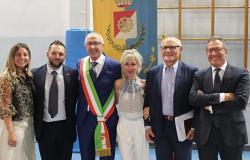The voters who will be called to the polls today and tomorrow will not only decide the composition of the European Parliament. There are also at play administrativethere is also the political fate of around 3,700 municipalities, with 17 million voters called to vote.
The regional capitals at stake are six (Bari, Cagliari, Campobasso, Florence, Perugia, Potenza) and 23 provincial capitals (Ascoli Piceno, Avellino, Bergamo, Biella, Caltanissetta, Cesena, Cremona, Ferrara, Forlì, Lecce, Livorno , Modena, Pavia, Pesaro, Pescara, Prato, Reggio Emilia, Rovigo, Sassari, Urbino, Verbania, Vercelli and Vibo Valentia). Not only.
In Piedmont we will also go to the polls for the regional elections. The administrative elections will be yet another test to test the strength of the so-called “right” camp, where, as we will see, it has been possible to achieve it.
The Regionals match in Piedmont
This is not the case in Piedmont, where the old disagreements between the local Democratic Party and the M5S, which developed during the time of Appendino as mayor, prevented the Giuseppe Conte (M5S) ed Elly Schlein (Pd) found an agreement. To thus challenge the outgoing governor Alberto Cirio of Forza Italia, running for the second mandate, will be the dem Gianna Pentenerowho for this reason left a department in the municipality of Turin, the pentastellata Sarah Disabatothe regional councilor Francesca Frediani of Unione Popolare, and the lawyer Alberto Costanzo. Particularly interesting is the challenge that will be played in Puglia.
The administrative match from Bari to Cagliari
In Bari the centre-left is divided while the centre-right appears united. On the one hand, in fact, there is the criminal lawyer Michele Laforgia, also supported by the M5S, the Italian Left and some lists in which there are former PDs. On the other there is the former chief of staff of the outgoing mayor Antonio Decaro: it’s about Vito Leccesesupported by the Democratic Party and six other lists.
In the centre-right, however, the parties have united to support the candidacy of the 36-year-old, former regional and municipal councilor of the Northern League, Fabio Romito.
The challenge in the Apulian capital is marked by the repercussions of the judicial investigations that have overwhelmed the center-left in recent months, including the arrests for political-mafia vote swapping in the 2019 municipal elections, which led to the sending of a ministerial commission to Bari .
It was precisely the investigations that pushed Cinquestelle leader Conte not to hold the primaries to choose the unified centre-left candidate and to support Laforgia.
In Lecce the united center-right supports Adriana Poli Bortone, in the past mayor of the Salento capital, parliamentarian, MEP and minister. The center-left in the Salento capital has instead found a square with the primaries around the outgoing candidate Carlo Salveminisupported by both the Democratic Party and the M5S.
The wide field in Sardinia seeks confirmation
After electing the first female president at the helm of the Region, the wide field that brings together the centre-left and M5S also tries to take over Cagliari, where five are competing but the duel will be Zedda against Zedda: Massimo for the centre-left and Alessandra for the centre-right .
The first, former child prodigy of the progressive area, outgoing regional councilor, has already led the municipality from 2011 to 2019. The centre-right, after an initial trouble, is aiming for revenge after the defeat in February by running Alessandra Zeddaformer vice-president of the Region with the council of Christian Solinaspassed from FI to the League.
Sassari is also among the provincial capitals up for vote, where the challenge is between the rector of the university, Gavino Mariottiwith the center-right, and the Dem Giuseppe Masciaformer M5S, supported by the broad camp of the centre-left.
From Campobasso to Florence
In Molise, eyes are on both the capital Campobasso and Termoli, the two most populous centers in the region. Campobasso has been led for the last five years by a single-party 5 Star party and this time the Movement appears in the progressive coalition, together with the Democratic Party, while the centre-right is playing the game to try to regain the capital where it has not administered for ten years.
The candidate for mayor is Marialuisa Forte, making his debut in politics, until now a school director. She is supported by three lists (Pd, 5 Star and a single list that unites the Greens, the Left and the Socialists). The center-right nominates the lawyer Aldo De Benedittis, who in the past was a municipal councilor.
Termoli is also a significant test because it is the city where the current president of the Region was mayor until last year Francesco Roberti: the centre-right is aiming for reconfirmation and presents itself as united while, unlike Campobasso, the centre-left has not found unity and is running with five different candidates.
Florence, Prato and Livorno: these are the three main challenges in the administrative round in Tuscany. The centre-left is therefore racing to reconfirm its ‘strongholds’ while the centre-right dreams of a turnaround and of conquering new key cities, Florence in the lead.
In the Tuscan capital there are 10 aspiring mayors, and while the centre-right presents itself as united, as in the other Tuscan capitals, in the opposite camp it is going in no particular order with an almost all-female challenge between three candidates and the solo race of M5S.
Try to pick up the baton of Dario Nardella Sara Funarosupported by a coalition with Pd, Azione, Si, +Europa, Verdi, Volt, Republican Party, Labor, Centro movement and Anima Firenze 2030 list.
In the absence of an agreement with the Democratic Party, Iv (with PSI and Libdem) fields the vice-president of the Region Stefania Saccardiand aim, as he said Matteo Renzito be the tip of the scales in a possible run-off.
Also in the running in the centre-left Cecilia Del Reformer councilor in the second Nardella council, from which she was removed in March 2023: she heads the Firenze Democratica list, after leaving the Democratic Party following a disagreement over the primaries that were not granted.
After long negotiations that never came to fruition, first with the 11 Agosto Association linked to Tomaso Montanari and then for a wide field with the Democratic Party, M5S runs with Lorenzo Masi.
It appears on the left Dmitrij Palagi, with Sinistra Progetto Comune (Possibile, Potere al Popolo and Prc), and environmentalist and supportive Florence. On the other side of the spectrum, the united center-right (FdI, Lega and FI) is betting on a non-political but well-known face in the city: Eike Schmidt, German from Freiburg who became an Italian citizen last November, he directed the Uffizi Galleries for eight years and is now at the helm, on leave, of the Capodimonte Museum in Naples.
Also on the field Andrea Asciuti, candidate of ‘Firenze Vera’, supported by Indipendenza di Alemanno and Popolo della Famiglia. Three house numbers complete the squad: Francesca Marrazza of ‘Ri-Bella Firenze’. Francesco Zini for Florence Cambia, e Alessandro De Giuli with Florence Reborn.
The case of the Umbrian laboratory
In Umbria, all eyes are on the regional capital, and in particular on two women – Margherita Scocciafor the center-right and civics, e Vittoria Ferdinandi which managed to obtain the support of an extra-large field from the Democratic Party to the M5S, from Action to Rifondazione, from Catholics to +Europa, from the socialists to the red-greens.
In Perugia it’s a five-way race. In addition to Scoccia and Ferdinandi, there are also Massimo Monni, which can count on a single list, Leonardo Caponi And Davide Baiocco.
From Potenza to Modena
After the 14 percentage point gap, 56 to 42, between the reconfirmed governor Vito Bardi (Forza Italia) and the centre-left candidate, Piero Marrese (Pd), in Potenza the centre-right majority, extended as in the Regional elections to the centrist forces of Action and Italia Viva, is decisively aiming to win in the first round with Francesco Fanelli (Lega), outgoing vice-president of the Council but not elected to the Regional Council.
The leader of the League will have to deal with three center-left candidates: the outgoing city councilors Vincenzo Telesca, Pierluigi Smaldone (supported by the M5S) e Francesco Giuzio. And with the outsider Maria Grazia Marino (Force of the People). The absence of the symbol of the Democratic Party on the ballot paper is significant, as it split over support for Telesca.
Among the provincial capitals, it is worth mentioning the match played in Bergamo where the Democratic Party’s seat is contested Giorgio Gorialready in his second term and candidate for the European elections, are there Elena Carnevali (dem candidate), Andrea Pezzotta (centre-right candidate) e Vittorio Apicella (candidate of the M5S). And that of Pesaro where, unlike Bergamo, the right pitch is there.
Four challengers for the aftermath Matteo Riccialso a candidate for the European elections. Andrea Biancani current regional councilor of the Democratic Party also supported by M5S and Avs; Marco Lanzi supported by the centre-right; Pia Perrici, the only female candidate supported by a list; Fabrizio Oliva supported by a civic list.
In Emilia-Romagna Pd and M5S everywhere together
In Emilia-Romagna we are voting to elect mayors and municipal councils of 226 municipalities (including the capitals Modena, Reggio Emilia, Ferrara, Forlì and Cesena) with our eyes focused on another election, the one that will choose the new president of the Region.
The current governor Stefano Bonaccini is candidate as leader of the Democratic Party in the European elections. Here the wide field was achieved almost everywhere: in particular in Modena, Bonaccini’s city and the largest among those where voting is held.
In support of Massimo Mezzetti in fact, there are the symbols of Pd, M5s, Avs, Azione and Italia Viva, i.e. the same coalition that the Pd hopes to propose to the regional elections. Against him Luca Negrini of Brothers of Italy.
Similar scheme also in Reggio Emilia where two civic officials compete: the doctor Marco Massari (centre-left) and the lawyer Giovanni Tarquini (centre-right).
In other cities the wide field operation was not 100% successful, even though the Pd, M5s and Avs are allies everywhere.
The challenge in Ferrara was interesting. Where there are four candidates for the office of mayor: for the centre-right there is the outgoing mayor, Alan Fabbri, for the center-left and M5S there is Fabio Anselmo. Part of the centre-left coalition, however, sided with the candidate Anna Zonari while Italia Viva supports Daniele Botti.






